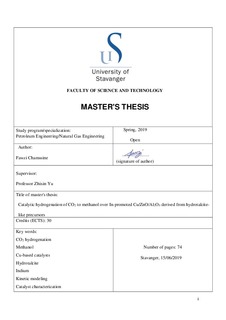| dc.contributor.advisor | Yu, Zhixin | |
| dc.contributor.author | Chamssine, Fawzi | |
| dc.date.accessioned | 2019-12-18T10:10:38Z | |
| dc.date.available | 2019-12-18T10:10:38Z | |
| dc.date.issued | 2019-06-15 | |
| dc.identifier.uri | http://hdl.handle.net/11250/2633863 | |
| dc.description | Master's thesis in Petroleum Engineering | nb_NO |
| dc.description.abstract | Carbon dioxide emissions present a threat on a global level, driving governments and the scientific society to search for sustainable solutions to ease the effects of climate change. Carbon utilization offers a potentially effective and environmentally friendly way to lower emissions by recycling carbon dioxide to produce valuable chemicals and fuels. Among these, methanol rises as an important component in the fuel sector as well as in the chemical industry. This creates a large potential for industrial utilization of CO2 hydrogenation to methanol.
Catalytic hydrogenation of carbon dioxide to methanol is performed using a heterogeneous catalytic system. The commercial Cu/ZnO/Al2O3 catalyst used for methanol synthesis from syngas has been extensively studied due to its relatively high performance and low cost compared to other catalytic systems. However, this catalyst requires improvements to reach the desired efficient industrial standard for CO2 hydrogenation to methanol. Hydrotalcite-derived Cu/Zn/Al2O3 catalyst has showed promising performance compared to the conventional Cu/ZnO/Al2O3 catalyst for methanol synthesis from CO2. Furthermore, it has been demonstrated that promotors (e.g. ZrO2, Ga2O3) can further improve the catalytic performance. Recently, the use of indium oxide has been proposed as a potential material for CO2 hydrogenation to methanol.
In this study, a series of Cu/ZnO/Al2O3 (CuZnAl) catalysts were prepared via hydrotalcite-like precursors. Different Cu/Zn ratios were implemented using co-precipitation (low saturation) preparation method. Indium (In) promoted catalysts were prepared with the best performing Cu/Zn ratio. The catalysts were characterized by x-ray diffraction, H2 temperature programed reduction, and N2 adsorption-desorption. Hydrotalcite structure was successfully achieved with the formation of CuO and ZnO particles after the calcination process. The addition of In improved CuO dispersion, the reducibility, and textural properties of the catalysts.
Catalytic performance was examined in a fixed-bed reactor at 250oC, 30 bars, and H2/CO2/N2 ratio of 3/1/1. A Cu/Zn ratio of 1 resulted in the highest methanol selectivity of 32.3%. The In promotion resulted in lower CO2 conversion but with a significant improvement in methanol selectivity. The highest methanol selectivity of 52.6% was obtained over the CuZnAl catalyst with an In content of 5 mol%. The superior performance of the In-promoted catalyst was further demonstrated at temperatures of 230°C to 260 °C. Furthermore, long term tests showed that In promotion significantly improved the stability of the catalyst. | nb_NO |
| dc.language.iso | eng | nb_NO |
| dc.publisher | University of Stavanger, Norway | nb_NO |
| dc.relation.ispartofseries | Masteroppgave/UIS-TN-IEP/2019; | |
| dc.subject | petroleumsteknologi | nb_NO |
| dc.subject | CO2 hydrogenation | nb_NO |
| dc.subject | Indium | nb_NO |
| dc.subject | Cu-based catalyst | nb_NO |
| dc.subject | methanol | nb_NO |
| dc.subject | catalyst characterization | nb_NO |
| dc.subject | hydrotalcites | nb_NO |
| dc.subject | kinetic modeling | nb_NO |
| dc.title | Catalytic hydrogenation of CO2 to methanol over In-promoted Cu/ZnO/Al2O3 derived from hydrotalcite-like precursors | nb_NO |
| dc.type | Master thesis | nb_NO |
| dc.subject.nsi | VDP::Technology: 500::Rock and petroleum disciplines: 510::Petroleum engineering: 512 | nb_NO |
